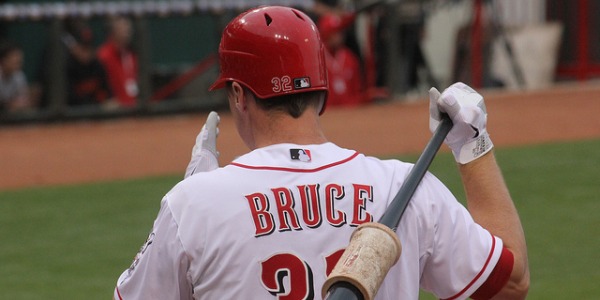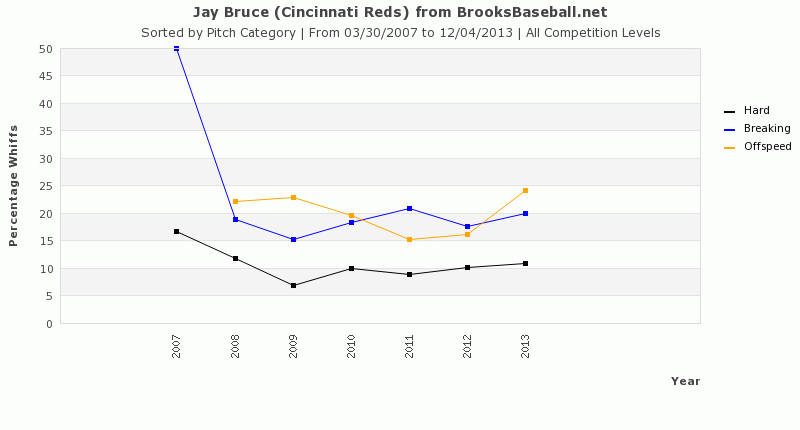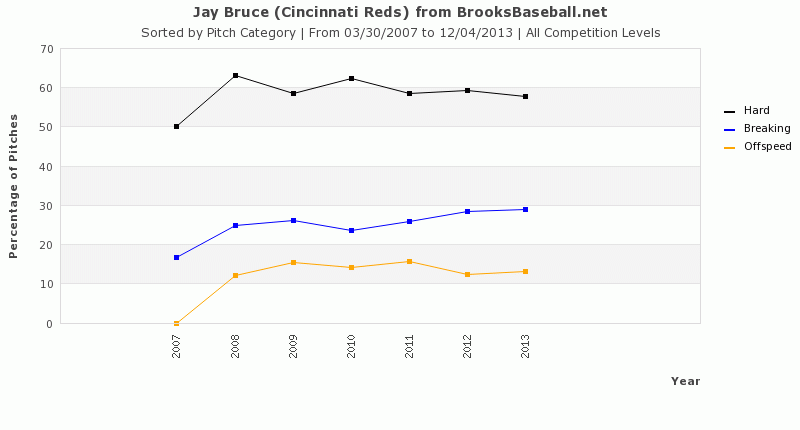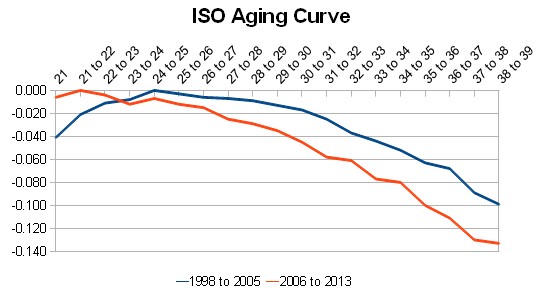2014 Fantasy Baseball: Is Jay Bruce Getting Worse?


Since his rookie season, echoes of Jay Bruce’s big potential breakout ring in your ears. The youth. The upside. The dingers. Each thought gets louder with every passing second on draft day.
Three, Two, One…it begins.
You ponder with an uneasy exhale and your draft rituals begin as the heart picks up the pace.
The snake turns. Off the board they come: Stanton, Puig, Pedroia…Your ritualistic twitch now in top gear. Your eyes press shut. A chime sounds.
They open. And Bruce sits atop the player list as your computer screen glows.
A thought: “Did I ever correct the contrast?”…wrong thought.
You see the digits tick down. Five, Four, Three…You click.
He’s yours; chosen over the likes of Bautista, Choo, Desmond, and Upton. Was it the right decision?
One isn’t usually concerned about a 27-year-old (happy birthday, Jay!) baseball player who will be aiming to hit 30 or more home runs for the fourth consecutive season. You may even say that is a sign of consistency. But consistency doesn’t exactly mean permanence. And although claiming a player may decline at the ripe age of 27 seems irrational, recent evidence states (here and here) that it isn’t as crazy as it seems. To put it in a more sane way, we shouldn’t necessarily expect a breakout from Bruce. But could there even be a small decline in production?
[am4show have=’p4;p3;p7;p11;’ guest_error=’Front Office’ user_error=’Front Office’ ]
Bruce has a strikeout problem, and since entering the league in 2008, the problem appears to have gotten worse. Last season, for the first time in his career, Bruce has eclipsed the 25% strikeout mark, finishing 2013 by striking out 26.5% of the time. He also had a 14.4% swinging strike percentage last year, the highest of his career and well above the league average. Since 2011, the walks have declined as well, down to nine percent in 2013.
Bruce is a lefty hitter who tends to struggle against left-handed pitching. Notice the drop-off against lefties after his 2010 season.
| Year | G | PA | BB% | K% | BB/K | AVG | OBP | SLG | OPS | ISO | BABIP | wOBA |
| 2008 | 66 | 152 | 7.2 % | 30.3 % | 0.24 | .190 | .263 | .299 | .562 | .109 | .258 | .256 |
| 2009 | 58 | 116 | 12.9 % | 24.1 % | 0.54 | .210 | .313 | .330 | .643 | .120 | .271 | .294 |
| 2010 | 90 | 179 | 10.6 % | 24.6 % | 0.43 | .277 | .352 | .547 | .899 | .270 | .308 | .388 |
| 2011 | 98 | 196 | 8.7 % | 30.1 % | 0.29 | .240 | .313 | .491 | .804 | .251 | .292 | .348 |
| 2012 | 89 | 194 | 9.3 % | 28.9 % | 0.32 | .225 | .304 | .450 | .754 | .225 | .255 | .322 |
| 2013 | 98 | 221 | 5.4 % | 26.2 % | 0.21 | .246 | .291 | .443 | .734 | .197 | .290 | .319 |
| Total | 500 | 1059 | 8.7 % | 27.5 % | 0.32 | .234 | .306 | .438 | .743 | .203 | .280 | .325 |
On the bright side, Bruce’s strikeout percentage decreased the last three seasons against southpaws. Other than that, there isn’t much to write home about as his on-base, slugging, ISO, and wOBA have all declined sharply since 2010.
As already noted, Bruce’s whiffs continue to rise.
The swings and misses occur on all pitch types, but the biggest spike was on offspeed offerings. I imagine right-handed pitchers with a changeup in their arsenal are taking notice.
Bruce is starting to see less fastballs, more breaking balls, and the amount of changeups thrown his way are also trending upwards. His contact percentage tumbled quite a bit last season.
| Year | O-Swing% | Z-Swing% | Swing% | O-Contact% | Z-Cntct% | Contact% | Zone% | SwStr% |
| 2008 | 32.2% | 71.6% | 50.6% | 56.1% | 81.3 % | 72.7% | 46.7% | 14.2% |
| 2009 | 30.8% | 67.7% | 47.3% | 58.2% | 87.2 % | 76.8% | 44.7% | 11.3% |
| 2010 | 28.7% | 68.8% | 46.7% | 50.9% | 86.0 % | 74.1% | 45.0% | 11.8% |
| 2011 | 30.6% | 69.3% | 47.9% | 52.5% | 86.5 % | 74.5% | 44.7% | 11.8% |
| 2012 | 29.2% | 69.9% | 47.4% | 53.1% | 84.8 % | 74.1% | 44.9% | 11.9% |
| 2013 | 30.0% | 71.0% | 49.2% | 47.7% | 81.4% | 70.5% | 46.8% | 14.4% |
| Total | 30.1% | 69.8% | 48.2% | 52.6% | 84.4% | 73.5% | 45.5% | 12.6% |
There is a lot not to like here. In 2013, 124 hitters acquired at least 400 plate appearances. Out of those 124 hitters, Bruce ranked eighth worst in outside-contact percentage, behind Adam Dunn and in front of Michael Saunders and Drew Stubbs. He was 13th worst in overall contact percentage.
Last season at age 26, Bruce hit .262/.329/.478 with 30 home runs. His ISO was .216, the lowest since his age-23 season. In 2012, during his age-25 season, Bruce’s ISO peaked at a career high .263. Thanks to the great Jeff Zimmerman, we can look at the league’s ISO Aging Curve chart and see if this makes sense. Let’s focus on the red line.
Well, wouldcha look at that? This chart shows us that a player’s ISO peaks at around age-25 and declines from there. Bruce seems to be right on course.
Between his performance trends and the recent aging curve evidence, Bruce is actually more likely to begin a decline at age-27 than transcend his past numbers. In short, he does not appear to be a breakout candidate waiting to happen. In fact, you could argue that we should expect a minor downturn in performance/production from 2013. Jay Bruce has been in the big leagues for six seasons, and unless he suddenly changes who he is, it looks like we are the ones who are going to have to change our expectations. [/am4show]









1 Comment
dumb!!!!!!!!!!!!!!!!!! thing to say about Jay